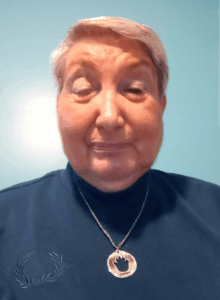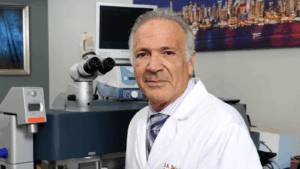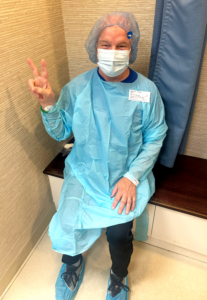Your eyes help you every day to read, watch TV, drive and more. Taking care of your eyes matters. However, some eye problems can be hard to notice early on.
Known as “the sneak thief of sight,” glaucoma can quietly damage your vision without any warning signs. Many people lose some sight before doctors diagnose the disease.
Schedule routine eye care during Healthy Aging Month to find issues before they affect your vision.
Study Focuses on Elevated Eye Pressure
Glaucoma is a group of eye conditions that can lead to vision loss or blindness. The disease damages the optic nerve, the part of your eye that sends visual information to your brain.
Harm to the optic nerve often occurs through increased pressure inside the eye. If damage occurs, any vision lost is irreversible.
A recent study published in Ophthalmology Science, focuses on how elevated eye pressure changes blood vessels in the eye.
“If we can understand that, we can inform drug delivery to improve blood flow in the back of the eye,” said Yi Hua, a University of Mississippi biomedical engineering professor, in Medical Xpress. “That can slow down the progression of glaucoma.”
Researchers used advanced 3D imaging and glowing dye to track how blood flows through the eye at different pressure levels.
The study showed extreme eye pressure resulted in a lack of oxygen in approximately 30 percent of the tissue in the optic nerve. According to the study, an oxygen deficit leads to cells dying and eventually loss of sight.
“The vision loss resulting from this damage cannot be recovered. Hence, it is crucial to find ways to detect the disease and prevent the damage before it happens,” Ian Sigal, associate professor of ophthalmology and bioengineering at the University of Pittsburgh, said in Medical Xpress.
Tests to Diagnose Glaucoma
Glaucoma is a leading cause of blindness in the U.S. It affects more than four million U.S. adults every year, according to a 2022 study. Of those, about 1.5 million people had vision-affecting glaucoma.
An annual comprehensive eye exam could help protect your sight for years to come. During the exam, your doctor may check for signs of glaucoma and other eye conditions using several tests:
- Tonometry measures pressure inside your eye.
- Ophthalmoscopy allows your doctor to examine the back of your eye and assess the shape and color of your optic nerve.
- Perimetry measures your field of vision.
- Gonioscopy looks at the drainage angle where your iris meets your cornea.
- Pachymetry measures the thickness of your cornea, which can affect eye pressure readings and help guide your care.
If an eye exam detects glaucoma, several treatment methods are available. Options may include traditional medications, surgical procedures or a combination of both. Talk with your eye doctor about which treatment is best for your vision health.
People at higher risk for glaucoma may need eye exams more frequently.
Know Your Glaucoma Risk Factors
Anyone can develop glaucoma, but risk factors make certain individuals more likely to develop the disease.
Risk factors for glaucoma include the following:
- Age 45 or older
- Family history of glaucoma
- History of injury to the eye
- Black American
- Diabetes
- Nearsighted (myopic)
- Farsighted (hyperopic)
- History of elevated intraocular pressure
- History of steroid use, either in the eye (drops) or systemically (orally or injected)
Schedule Your Comprehensive Eye Exam
Healthy Aging Month reminds us to focus on maintaining good vision as we get older. Getting an annual comprehensive eye exam is an easy way to protect your sight.
Our board-certified ophthalmologists are accepting new patients. Schedule an appointment for a comprehensive eye exam at one of our eye care centers near you.
 A few months after the Niagara Falls trip, Titus met with ophthalmologist Adrian Jachens, MD, to talk through what was best for her long-term vision, because not every procedure was right for her eyes.
A few months after the Niagara Falls trip, Titus met with ophthalmologist Adrian Jachens, MD, to talk through what was best for her long-term vision, because not every procedure was right for her eyes. Cataracts are a common cause of vision loss, especially as we get older. The Centers for Disease Control and Prevention report that more than 20.5 million people in the U.S. aged 40 and older have cataracts.
Cataracts are a common cause of vision loss, especially as we get older. The Centers for Disease Control and Prevention report that more than 20.5 million people in the U.S. aged 40 and older have cataracts. A retired probation officer from Rutherford, New Jersey, Rhodes, 77, appreciates the importance of clear vision. A year ago, she was diagnosed with Bell’s palsy, a neurological disorder that causes paralysis or weakness on one side of the face.
A retired probation officer from Rutherford, New Jersey, Rhodes, 77, appreciates the importance of clear vision. A year ago, she was diagnosed with Bell’s palsy, a neurological disorder that causes paralysis or weakness on one side of the face. Dr. DeLuca’s office partners with the Lions Eye Bank for Long Island, a not-for-profit organization dedicated to fighting corneal blindness. After several weeks, Lions Eye Bank notified the office that a 24-year-old man passed away and his family opted for organ donation.
Dr. DeLuca’s office partners with the Lions Eye Bank for Long Island, a not-for-profit organization dedicated to fighting corneal blindness. After several weeks, Lions Eye Bank notified the office that a 24-year-old man passed away and his family opted for organ donation. Ten months later, Rhodes administers daily eye drops for
Ten months later, Rhodes administers daily eye drops for  Retiree Bruce Barkhorn frequently fishes for striped bass off the coast of Keyport, New Jersey.
Retiree Bruce Barkhorn frequently fishes for striped bass off the coast of Keyport, New Jersey. When cataracts affected his night vision, Barkhorn made an appointment with ophthalmologist Shawn R. Klein, MD, to discuss his eye care.
When cataracts affected his night vision, Barkhorn made an appointment with ophthalmologist Shawn R. Klein, MD, to discuss his eye care. Barkhorn underwent cataract surgery on his left eye at
Barkhorn underwent cataract surgery on his left eye at